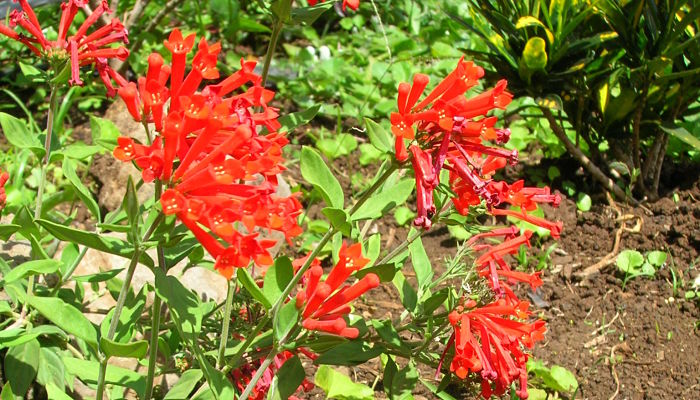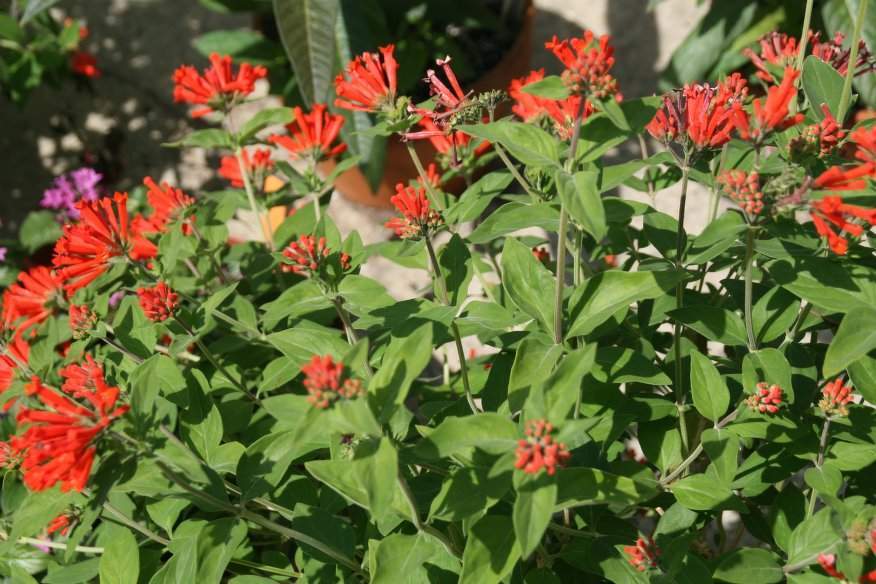Latin Name:
Bouvardia ternifolia (Schltdl.) Standl.
Common Names:
Trompetilla, Flower Rod, Cantaris, Cerillito, Chilillo, Cigarette, Cometa, Erysipelas, Brush, Valletta Flower, Donkey Grass, Indian Grass, Viper Tongue, Virgin Shadow, Vara de Flor, Cántaris, Cerillito, Chilillo, Cigarrillo, Cometa, Erisipela, Escobilla, Flor de Valleta, Hierba del Burro, Hierba del Indio, Lengua de Víbora, Sombra de la Virgen.
Family:
Rubiaceae
Description
Bouvardia ternifolia, commonly known as Trompetilla or Trumpet, is a perennial shrub belonging to the Rubiaceae family. This plant typically grows to a height of 0.5 to 1.5 meters, characterised by its erect or sprawling stems. The leaves are opposite, ovate to lanceolate, measuring 2-5 cm in length, with a smooth or slightly pubescent texture. The plant is most notable for its vibrant, tubular flowers, which are typically scarlet red, though occasionally pink or white variants occur. These flowers, arranged in terminal clusters, are approximately 2-3 cm long, with a trumpet-like shape that gives the plant its common name. The blooming period typically spans from late spring to early fall, attracting pollinators such as hummingbirds and butterflies.
Distribution and Habitat
Trompetilla is primarily distributed across North and Central America, with notable populations in the United States (Arizona, New Mexico, Texas) and Mexico (Durango, Morelos, and other regions). It thrives in diverse ecosystems, including:
- Pinus-Quercus forests: Mixed pine-oak woodlands at elevations of 1200-2600 meters.
- Liquidambar deciduous forests: Areas dominated by sweetgum trees, often in cooler, moist environments.
- Thickets and shrublands: Open, sunny areas with well-drained soils.
The plant prefers temperate climates, well-drained soils, and partial to full sun exposure, making it adaptable to a variety of ecological niches within its range.
Traditional Medicine
Trompetilla has a rich history of use in traditional medicine, particularly among indigenous and local communities in Mexico. Its applications are diverse, reflecting its perceived therapeutic versatility:
-
Snakebites: In Morelos, Mexico, Trompetilla is a primary remedy for viper bites. The leaves and stems are macerated and applied topically to the bite site to reduce venom effects and inflammation.
- Insect and Arachnid Stings: Decoctions made by boiling the stems and leaves in water are used for bathing to alleviate pain and swelling from bee, scorpion, spider, centipede, or ant stings. Alternatively, macerated leaves or ground young branches are applied directly to the affected area or preserved in alcohol for use as a topical rub.
- Gastrointestinal Issues: The plant is used to treat dysentery and stomach pain. Infusions or decoctions of the leaves are consumed to soothe digestive discomfort.
- Respiratory Conditions: Trompetilla is employed to relieve symptoms of whooping cough, likely due to its sedative properties, which may calm spasmodic coughing.
- Skin Conditions: The plant is applied topically to treat pimples and vaginal abscesses, leveraging its purported anti-inflammatory and antimicrobial properties.
- Analgesic and Sedative Effects: Traditional healers attribute pain-relieving and calming properties to Trompetilla, using it for general pain management and to promote relaxation.

Herbal Recipes
Below are a few traditional herbal recipes utilising Trompetilla, based on its documented uses in Mexican traditional medicine. These recipes should be used with caution, and consultation with a healthcare professional is advised, especially for internal use.
1. Trompetilla Decoction for Insect Stings
Purpose: To relieve pain and swelling from bee, scorpion, spider, centipede, or ant stings.
Ingredients:
- 1 handful of fresh Trompetilla leaves and stems (approximately 20-30 grams)
- 1 litre of water
Instructions:
- Rinse the fresh leaves and stems thoroughly to remove dirt.
- Bring 1 litre of water to a boil in a pot.
- Add the Trompetilla leaves and stems, reduce heat, and simmer for 10-15 minutes.
- Remove from heat and let the decoction cool to a comfortable temperature.
- Strain the liquid and use it to bathe the affected area 2-3 times daily until symptoms subside.
Storage: Use immediately or store in a clean container in the refrigerator for up to 24 hours.
2. Trompetilla Poultice for Snakebites
Purpose: To reduce inflammation and pain from viper bites (seek medical attention immediately for snakebites).
Ingredients:
- 2-3 handfuls of fresh Trompetilla leaves or young branches
- Clean cloth or bandage
Instructions:
- Wash the fresh leaves or young branches thoroughly.
- Crush or macerate the plant material using a mortar and pestle or clean hands until a paste forms.
- Apply the paste directly to the snakebite area.
- Cover with a clean cloth or bandage to keep the poultice in place.
- Replace with a fresh poultice every 4-6 hours as needed.
Note: This is a traditional remedy and should complement, not replace, professional medical treatment for snakebites.
3. Trompetilla Tincture for Topical Pain Relief
Purpose: To alleviate general pain or skin irritations through topical application.
Ingredients:
- 50 grams of fresh or dried Trompetilla leaves and stems
- 250 ml vegetable glycerine or high-proof alcohol (eg. at least 40% alcohol)
- Glass jar with a tight lid
Instructions:
- Chop the Trompetilla leaves and stems finely.
- Place the plant material in a clean glass jar.
- Pour the alcohol over the plant material, ensuring it is fully submerged.
- Seal the jar tightly and store it in a cool, dark place for 2-3 weeks, shaking gently every few days.
- Strain the liquid through a cheesecloth or fine mesh into a clean bottle.
- Apply a small amount to the affected area using a clean cloth or cotton ball, 1-2 times daily as needed.
Storage: Store in a cool, dark place for up to 6 months.
4. Trompetilla Infusion for Digestive Discomfort
Purpose: To soothe stomach pain or dysentery.
Ingredients:
- 10-15 grams of dried Trompetilla leaves
- 500 ml of boiling water
- Agave or sweetener (optional)
Instructions:
- Place the dried leaves in a heat-resistant container.
- Pour 500 ml of boiling water over the leaves.
- Cover and let steep for 10-15 minutes.
- Strain the infusion and let it cool to a drinkable temperature.
- Drink 1 cup (about 150-200 ml) up to twice daily for digestive relief. Add agave if desired for taste.
Storage: Prepare fresh daily, as the infusion does not store well.
Caution: Internal use should be limited due to limited safety data.
Phytochemical Profile
While comprehensive studies on Bouvardia ternifolia are limited, preliminary research suggests the presence of bioactive compounds typical of the Rubiaceae family, including:
- Alkaloids: Potentially responsible for sedative and analgesic effects.
- Flavonoids: Contribute to anti-inflammatory and antioxidant properties.
- Terpenoids: May support antimicrobial activity, useful in treating infections or skin conditions.
- Saponins: Could explain its use in topical applications for skin healing.
Further pharmacological studies are needed to validate these compounds and their specific contributions to Trompetilla’s medicinal effects.
Cultivation and Propagation
Trompetilla is relatively easy to cultivate, making it a candidate for both ornamental and medicinal gardens:
- Soil: Prefers well-drained, loamy soils with a neutral to slightly acidic pH.
- Light: Thrives in full sun to partial shade.
- Water: Moderate watering, allowing the soil to dry out between sessions to prevent root rot.
- Propagation: Can be propagated via seeds or stem cuttings. Seeds should be sown in spring, while cuttings are best taken from semi-hardwood stems during the growing season.
-
Maintenance: Pruning encourages bushier growth and enhances flowering. The plant is moderately drought-tolerant once established but benefits from occasional fertilisation.
Ecological and Cultural Significance
Trompetilla plays an important ecological role as a pollinator attractant, particularly for hummingbirds, which are drawn to its bright, nectar-rich flowers. Its presence in mixed forests contributes to biodiversity by supporting local pollinator populations. Culturally, the plant holds a significant place in Mexican herbal traditions, often passed down through generations as a remedy for bites, stings, and other ailments. Its numerous common names reflect its widespread use and recognition across different communities.
Precautions and Considerations
- Toxicity: While Trompetilla is widely used in traditional medicine, there is limited data on its safety profile. Excessive use or improper preparation may cause adverse effects, particularly when consumed orally.
- Allergies: Topical applications may cause skin irritation in sensitive individuals. A patch test is recommended before widespread use.
- Consultation: Individuals with pre-existing medical conditions or those on medication should consult an experienced herbalist or natural healthcare professional before using Trompetilla, especially for internal use.
- Sustainability: Overharvesting in wild populations could threaten local ecosystems. Cultivation is encouraged to meet medicinal demand sustainably.
Conclusion
Bouvardia ternifolia, or Trompetilla, is a versatile plant with a rich ethnobotanical heritage and ecological value. Its striking flowers, wide-ranging medicinal applications, and accessible herbal recipes make it a valuable resource in both traditional healing and ornamental gardening. While its traditional uses are well-documented, further scientific research is needed to fully understand its phytochemical properties and ensure safe, effective use. For those interested in exploring its benefits, sustainable cultivation and cautious application are recommended to preserve its natural populations and maximise its therapeutic potential.
Notes
- The herbal recipes were adapted from traditional practices described in sources like Argueta (2011) and Heinrich et al. (1998), with modifications for clarity and safety based on general herbalism guidelines.
- Limited phytochemical data exists for Bouvardia ternifolia specifically, so references to Rubiaceae family compounds (e.g., alkaloids, flavonoids) are drawn from broader studies, such as those in Bye & Linares (1983).
- For further exploration, you may consult local herbalists or ethnobotanical databases, as you’ve previously shown interest in elder knowledge and resources like Plants for a Future.
References
- Vibrans, H. (Ed.). (2020). Weeds of Mexico: Bouvardia ternifolia. Conabio. Available at: http://www.conabio.gob.mx/malezasdemexico/rubiaceae/bouvardia-ternifolia/fichas/ficha.htm
- Provides detailed botanical information, distribution, and habitat preferences for Bouvardia ternifolia in Mexico.
- Bye, R., & Linares, E. (1983). The role of plants in traditional medicine in Mexico. Journal of Ethnobiology, 3(2), 133-145.
- Discusses the ethnobotanical uses of Rubiaceae family plants, including Bouvardia species, in Mexican traditional medicine.
- Heinrich, M., Ankli, A., Frei, B., Weimann, C., & Sticher, O. (1998). Medicinal plants in Mexico: Healers’ consensus and cultural importance. Social Science & Medicine, 47(11), 1859-1871.
- Documents the use of Bouvardia ternifolia for snakebites and other ailments in Morelos, Mexico, based on interviews with traditional healers.
- Tropicos.org. (2025). Bouvardia ternifolia (Schltdl.) Standl. Missouri Botanical Garden. Available at: http://www.tropicos.org/Name/33500020
- Offers taxonomic details and distribution data for Bouvardia ternifolia across North and Central America.
- Argueta, A. (2011). Atlas de las Plantas de la Medicina Tradicional Mexicana. Instituto Nacional Indigenista, Mexico.
- Details traditional preparations of Trompetilla for snakebites, insect stings, and digestive issues, including decoctions and poultices.
- Plants for a Future (PFAF). (2025). Bouvardia ternifolia. Available at: https://pfaf.org/user/Plant.aspx?LatinName=Bouvardia+ternifolia
- Provides information on cultivation, ecological roles, and traditional uses of Trompetilla, with a focus on its medicinal applications.
- Martínez, M. (1969). Las Plantas Medicinales de México. Ediciones Botas, Mexico City.
- A classic text on Mexican medicinal plants, including Trompetilla’s use for viper bites, skin conditions, and respiratory issues.
- Villalobos-Flores LE, Espinosa-Torres SD, Hernández-Quiroz F, Piña-Escobedo A, Cruz-Narváez Y, Velázquez-Escobar F, Süssmuth R, García-Mena J. The Bacterial and Fungal Microbiota of the Mexican Rubiaceae Family Medicinal Plant Bouvardia ternifolia. Microb Ecol. 2021 Sep 22. doi: 10.1007/s00248-021-01871-z. Epub ahead of print. PMID: 34553243.
This article is copyrighted by Ital is Vital, 2025. Want to re-post this article? Visit our guidelines.
DISCLAIMER: THIS WEBSITE DOES NOT PROVIDE MEDICAL ADVICE
The information, including but not limited to, text, graphics, images and other material contained on this website are for informational purposes only. The purpose of this website is to promote broad consumer understanding and knowledge of various health topics. It is not intended to be a substitute for professional medical advice, diagnosis or treatment. Always seek the advice of your physician or other qualified health care provider with any questions you may have regarding a medical condition or treatment and before undertaking a new health care regimen, and never disregard professional medical advice or delay in seeking it because of something you have read on this website.
